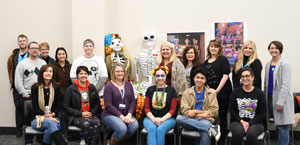

 National Park College’s (NPC) Cultural Diversity Awareness Club hosted a celebration
in observance of Dia de los Muertos.
National Park College’s (NPC) Cultural Diversity Awareness Club hosted a celebration
in observance of Dia de los Muertos.
Guest speaker, Erin Holliday, Emergent Arts Executive Director explained that the
holiday is much closer to our Memorial Day than Halloween. It looks more like Halloween
because skeletons and skulls are used, but it is actually about memorializing people
who have passed and honoring those who came before us.
Dia de los Muertos is not celebrated everywhere in Mexico or Latin America, but is
prominent in Mexico City, Oaxaca, and Jalisco, and certain mountainous areas. Sometimes
it is celebrated for weeks. In some areas, it is more of a casual moment to remember
those who have come before.
The ofrenda, or altar, might include food that the deceased person liked, pictures
of them, and anything else to make it a happy place for them to return. It is a way
to celebrate their memory with objects that symbolized some of the things that they
loved.
Marigolds are often found on ofrendas. The pollen has phosphorescent qualities, allowing
it to glow in the dark. Marigolds also line the streets so as the spirits return and
come down, they can follow the roads back to their homes.
Typically made out of tissue or a lighter paper, papel picado is another prominent
image. Holliday shared that altars oftentimes have all four elements in them, so papel
picado is a good way to represent air, or wind, as papel picado will move with the
movement of the air.
Molded skulls made from sugar and meringue powder are also common during the holiday.
Eating sugar skulls is a celebration of life and making fun of death and consuming
an image that is attributed to death. The skulls are sweet, representing consuming
the sweetness of life, and overcoming that fear of death in the process.
Monarch butterflies are also significant to the holiday. Holliday explained that
there are certain places in Mexico where the Day of the Dead only begins when the
monarch butterflies arrive. They believe that the souls of the elders arrive on the
wings of the butterflies.
"Personally, I think it is such an incredibly healthy way to look at death and loss,
because it is about remembering people all year round, but specifically on those days,
and celebrating them," Holliday said.